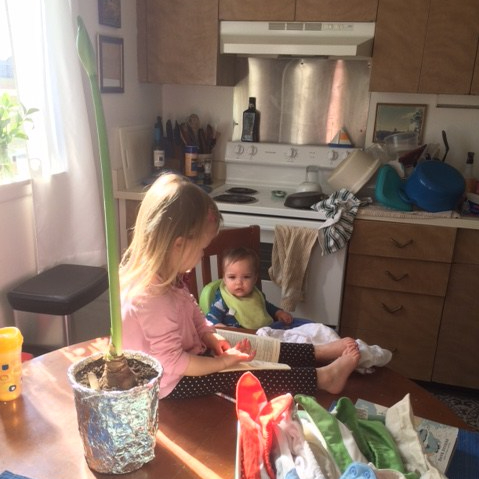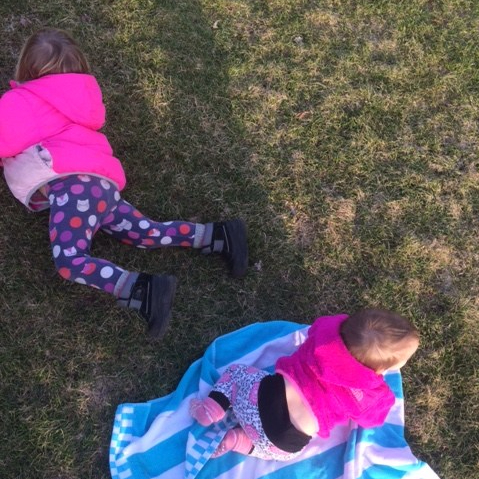We do not really want a religion that is right where we are right. We want a religion that is right where we are wrong. – G.K. Chesterton
As a way of response to the bemoaning in some circles of the Church’s “irrelevancy,” re the 50th anniversary of “Humanae vitae,” (the papal encyclical that reiterated the Church’s stance on contraception,) I’d like to share the story of how the Church wooed this millennial home.
Unity, contraception, and authority – the super sexy buzzwords that shaped my journey from the evangelical world to the Catholic Church. I became Catholic at a Friday afternoon Mass less than a week after my first baby was baptized into the Church. A couple days before, I had a surge of doubt – How did I get to this point? Am I making the right decision? But when I sat down and thought about my spiritual course of the last few years, I felt overwhelming peace. Having been raised in the nondenominational, evangelical Christian world, I had learned to look to Jesus. To make decisions with the question in mind, Will this lead me closer to God? Will this require me to trust Him more? I was reassured, only Jesus could have led to me this place of trust, where I was ready to submit to the authority of His Church and cross the Tiber.
As a college student in the Bay Area, discovering the Church as a two thousand year old institution that has the audacity to hold to crazy truths that Protestant denominations have abandoned was shocking and challenging and, strangely, very compelling. I probably asked Chris, the one Catholic in our university evangelical student group (now my husband), a million times – You actually believe this? Oh yeah, and there was that. I also happened to find Chris very compelling. Contemplative and competitive, deep and fun, he really seemed to love Jesus … and yet, he was Catholic. Why do you have to go to Mass every Sunday? Why do you pray to Mary? If you eat Jesus, aren’t you a cannibal? I was a bit sassy, but, not so secretly, very intrigued.
I went to a Spanish Mass with Chris in Oakland throughout the summer of 2011 and when I studied abroad in Spain that fall, I found myself going to Mass with a new friend in the program. She was Catholic, and I continued to ask questions. I couldn’t receive the Eucharist, and had some awkward bumbles asking the priest for a bendición when I stepped forward in the communion line, but I went back week after week. The Mass was the same everywhere! If it was true, Jesus was physically present in millions of churches all around the world. Chris, back in California, was hearing the same scripture readings. A unified, global Church! The ritual and form was such, I could participate in a different language. I learned that Catholics fasted the hour before receiving the Eucharist; they didn’t bring their bagels into the pews. Church as a sacred space? Didn’t the Church know it was supposed to appeal to my generation with amplified music and hipster coffee in the foyer?
When I returned to Stanford, I still wasn’t sure about Catholicism, but I was pretty sure about Chris.
“I think we should date,” I said.
“Let me think about it,” he said.
And when he got back to me, he said, “I want to date you, but there’s two things you should know. I’m fine with marrying a Protestant, but I want to raise my kids Catholic, and I want to follow Church teaching on contraception.”
WHAT THE WHAT. There’s Church teaching on contraception?
I was shocked to learn that yes, in fact, the Church holds to the traditional Christian view that contraception is a moral issue and it is wrong.
And in fact, Protestants believed and taught this until 1930, when the Anglican Church announced contraception to be acceptable in certain circumstances and other denominations followed suit in the decades after. I had no idea. This rocked my world because every single Christian in my life until this point, once married, had no problem with using contraception. In fact, it seemed to be encouraged. Babies are blessings, but they are planned blessings. Faced with this news, I set about learning more because a) I wanted to date Chris and b) I didn’t want to be a Duggar.
I learned that the Church teaches that sex is inherently unitive, pleasurable, and procreative. I learned that for millennia, Christians have believed that the sexual act is, by nature, tied to co-creating life with God. And further, that couples don’t have the right to actively mess with that (sacred) reality. What about couples who are infertile? What about women past menopause? Neither of those cases involve the couple actively interfering with the sexual act to render it sterile – there’s nothing immoral about infertility. (Though it’s true that the Church has a long way to go in its pastoral care for couples struggling with this).
I learned that the Church teaches that couples can track their fertility to avoid or achieve a pregnancy. There are many methods of fertility tracking, but they are lumped together in the Catholic world under the title, Natural Family Planning.
When a couple is highly motivated and uses NFP effectively, it has a 98 percent success rate in avoiding a pregnancy. Well, isn’t that just Catholic birth control, then? Nope. A couple using NFP to avoid a pregnancy doesn’t do anything to alter the sexual act. They abstain from sex when the woman is fertile, following her body’s natural rhythms. It’s an ongoing conversation between themselves and God, month by month, but in general, there’s an attitude, an orientation, that is open to life as each sexual act is open to the possibility of life.
I found all this very new and alarming. And fascinating. People actually do this?? Do they all have a ton of kids because NFP doesn’t work or because they just want to? The vast majority of families I knew growing up had two kids and then were “done.” I was also intrigued because I knew basically nothing about my fertility.
I met with a married woman I knew who had recently converted to Catholicism to ask her about NFP. How does it actually work? She explained briefly how she tracked her fertility, and then told me that her husband actually wrote down her observations each day. He was intimately familiar with her cycle and could see, with her, if she was stressed or sick, from the signs her body was giving her. My take away from this was – I have no idea what cervical mucus even is! It can tell you that you’re sick?? But I was drawn to several points from what she shared. Her husband cared about her fertility. The man could discuss cervical mucus! He had a vested interest in it. And this led me think about, for the first time ever, I don’t want to be the one responsible for if I get pregnant or not. If I get married, I want my spouse to share that with me equally. And a second thought, I don’t want to ever feel used by my spouse, or use him. If we could take only the pleasurable aspect of sex and not the other reality of possibly creating life, by rejecting part of my body, namely, my fertility – well, that didn’t seem as right to me anymore. I wanted to be all in, with him, holding nothing back. It started to make more sense that for something as intimate and powerful as sex, there would be a lot of self-sacrifice involved for the sake of the other.
It was the strangest thing, but as I learned more about NFP, I found more and more that it seemed empowering of women. I met with a nurse and NFP instructor in San Jose and she taught me more about my body than I had ever learned in health class. My body is amazing! Women are amazing! Why aren’t we all taught how to track our fertility? This coincided with an obsession I had with midwifery, and there’s a lot of rhetoric in the birth world about how strong and goddess-like women are, so I was riding a feminist high. This feels like true feminism! Why is the pill given as a solution for any female problem? Why are we told to medicate our fertility away?
Learning more of the why’s and how’s of NFP led me to start considering the authority of the Church. “No contraception” felt like a super personal, crazy demand that the Church somehow had the boldness to impose on me and my sex life… but as a Protestant, I had come to profess Jesus as Lord. And that meant He had authority over my life. This was a foundational part of youth group, college ministry, church on Sunday, you name it. Give your life to Jesus. “Your life” included how you thought about your studies, future career, justice, money, friendships, and sex. I am so grateful for this formation. It molded my heart, from a young age, with an inclination towards radical trust in the Divine Will. But I never once heard anyone talk about Jesus having authority over family planning. Trust God with the number of kids I’m going to have? That’s going a little far, wouldn’t you say?
And yet, why? It began to feel inconsistent. I looked at the spiritual mentors in my life – people living out their love for God in their decisions about money, their work for justice, their sharing of the gospel with word and deed– it seemed nothing in their lives was outside of God’s control. Except, it seemed, accepting children. Save sex until marriage, and then, go crazy? I assumed so, but didn’t really know; it wasn’t talked about. The vibe I gleaned from excitement about engagement and weddings (though, granted, this wasn’t huge in the Bay Area,) was once you’re married, all that chastity and self-control stuff is finally a thing of the past! And this felt odd to me. It started to make much more sense that I was practicing self-control and practicing chastity for when I would need to use those virtues in the rest of my life. If using NFP cultivated self-control in the relationship between a married couple, wouldn’t that be good, not just for the individual, but also the marriage?
There were these flashes, then, when the Catholic Church didn’t seem quite so crazy. Or, if crazy, at least consistently crazy, and very confident of its authority to proclaim truth, which was interesting. I kept getting glimpses of how this counter-cultural lifestyle would require me to trust God more than I ever had to before. If the Church seems more consistent on the sex thing, what else might it be right about? Rather than pushing me away, it drew me in.
I kept reading and asking questions, praying and seeking God’s will. I felt my heart open and continue to soften until I felt I could agree to raise my kids Catholic and do this NFP thing. So, still Protestant, I married Chris in a Catholic church. I went to Mass on Sundays and let the Holy Spirit speak to me, often through the gift of tears . And in perfect timing, it led me to that Friday afternoon Mass at the end of October, my husband holding our two month old daughter who had been baptized six days earlier. I felt the chrism oil dripping down my forehead and knew, when the priest said, “Be sealed with the Holy Spirit,” I could say, “Amen,” because it was Jesus who had brought me home to His Church.












